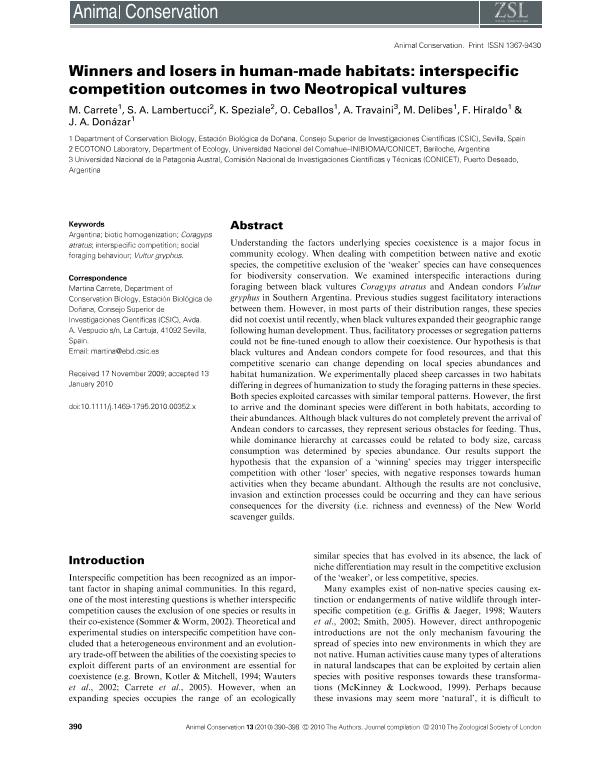Artículo
Winners and losers in human-made habitats: Interspecific competition outcomes in two Neotropical vultures
Carrete, Martina ; Lambertucci, Sergio Agustin
; Lambertucci, Sergio Agustin ; Speziale, Karina Lilian
; Speziale, Karina Lilian ; Ceballos, O.; Travaini, Alejandro
; Ceballos, O.; Travaini, Alejandro ; Delibes, M.; Hiraldo, F.; Donázar, José Antonio
; Delibes, M.; Hiraldo, F.; Donázar, José Antonio
 ; Lambertucci, Sergio Agustin
; Lambertucci, Sergio Agustin ; Speziale, Karina Lilian
; Speziale, Karina Lilian ; Ceballos, O.; Travaini, Alejandro
; Ceballos, O.; Travaini, Alejandro ; Delibes, M.; Hiraldo, F.; Donázar, José Antonio
; Delibes, M.; Hiraldo, F.; Donázar, José Antonio
Fecha de publicación:
07/2010
Editorial:
Wiley Blackwell Publishing, Inc
Revista:
Animal Conservation
ISSN:
1367-9430
Idioma:
Inglés
Tipo de recurso:
Artículo publicado
Clasificación temática:
Resumen
Understanding the factors underlying species coexistence is a major focus in community ecology. When dealing with competition between native and exotic species, the competitive exclusion of the 'weaker' species can have consequences for biodiversity conservation. We examined interspecific interactions during foraging between black vultures Coragyps atratus and Andean condors Vultur gryphus in Southern Argentina. Previous studies suggest facilitatory interactions between them. However, in most parts of their distribution ranges, these species did not coexist until recently, when black vultures expanded their geographic range following human development. Thus, facilitatory processes or segregation patterns could not be fine-tuned enough to allow their coexistence. Our hypothesis is that black vultures and Andean condors compete for food resources, and that this competitive scenario can change depending on local species abundances and habitat humanization. We experimentally placed sheep carcasses in two habitats differing in degrees of humanization to study the foraging patterns in these species. Both species exploited carcasses with similar temporal patterns. However, the first to arrive and the dominant species were different in both habitats, according to their abundances. Although black vultures do not completely prevent the arrival of Andean condors to carcasses, they represent serious obstacles for feeding. Thus, while dominance hierarchy at carcasses could be related to body size, carcass consumption was determined by species abundance. Our results support the hypothesis that the expansion of a 'winning' species may trigger interspecific competition with other 'loser' species, with negative responses towards human activities when they became abundant. Although the results are not conclusive, invasion and extinction processes could be occurring and they can have serious consequences for the diversity (i.e. richness and evenness) of the New World scavenger guilds.
Archivos asociados
Licencia
Identificadores
Colecciones
Articulos(INIBIOMA)
Articulos de INST. DE INVEST.EN BIODIVERSIDAD Y MEDIOAMBIENTE
Articulos de INST. DE INVEST.EN BIODIVERSIDAD Y MEDIOAMBIENTE
Articulos(SEDE CENTRAL)
Articulos de SEDE CENTRAL
Articulos de SEDE CENTRAL
Citación
Carrete, Martina; Lambertucci, Sergio Agustin; Speziale, Karina Lilian; Ceballos, O.; Travaini, Alejandro; et al.; Winners and losers in human-made habitats: Interspecific competition outcomes in two Neotropical vultures; Wiley Blackwell Publishing, Inc; Animal Conservation; 13; 4; 7-2010; 390-398
Compartir
Altmétricas



